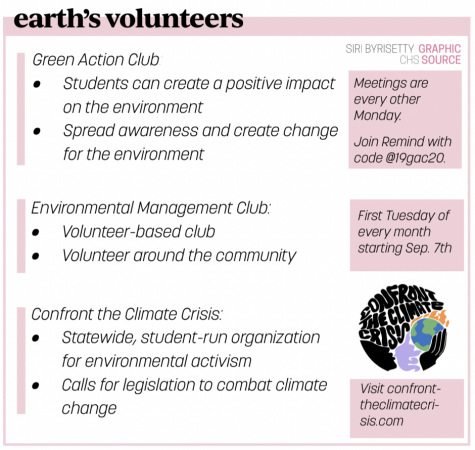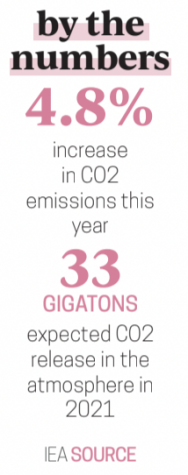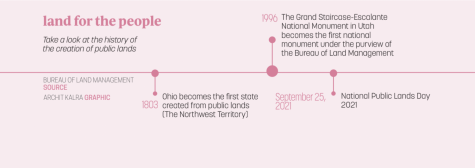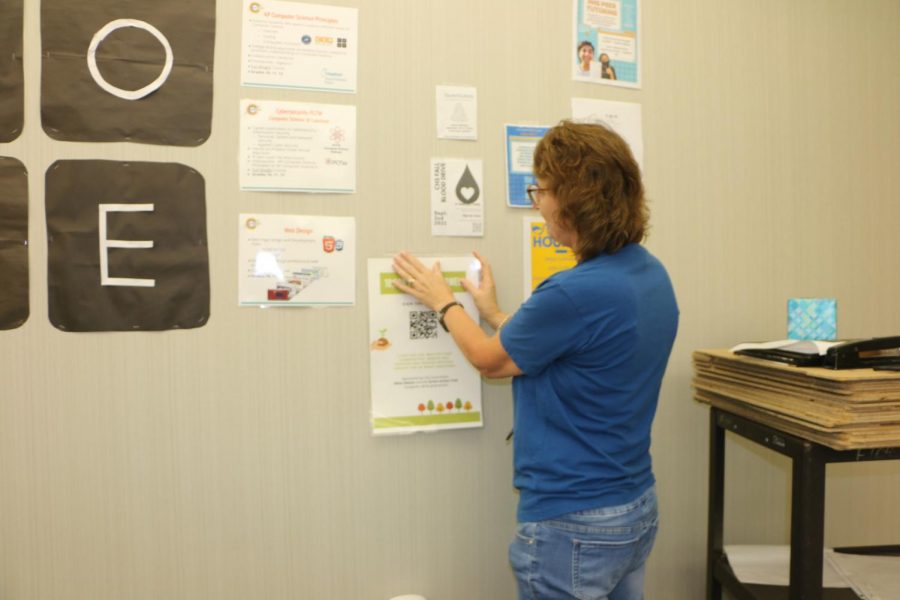National Public Lands Day is this Saturday, and volunteering for public lands lends more attention to environmental groups at this school.
CHS has a variety of opportunities for students to get involved with public lands and ecological maintenance. Because of the global environmental crisis, students like senior Lourdes Bengero and teachers like Fran Rushing, a former AP Environmental Science teacher, said treating education about sustainable living and human impact on the environment as increasingly important.

They said this is especially true in both the curriculum and general school lives of students who are further educated with opportunities and knowledge about the difference that they can make at this school.
Fran Rushing said she finds ways to show that messaging in her classes.
“We kind of layer on top of ecology information and talk about what we have done to the environment and how we have impacted the environment in good ways and bad ways, and what we could do better,” she said.
She said the AP Environmental Science class is one of the numerous options students have to become more educated ecological consumers and consider their possible influence on the environment.
Rushing said an additional opportunity for students to learn about the environment is through the newly established Environmental Management Club, which she advises. She said the club, which has yet to meet, will focus on environmental improvement initiatives and addressing problems within the public lands around Carmel by creating a student volunteer base.
Rushing said this class is what encouraged many of her students to pursue further environmental management initiatives outside of school.
National Public Lands Day is issued by the National Environmental Education Foundation (NEEF). NEEF provides data which depicts how a large part of caring for the public lands is based on the thousands of people who take the initiative to volunteer.
Along those lines, students at this school who have taken responsibility for public lands make up the Green Action Club (GAC). The club has various facets which work together as a unit. Within the education committee, for example, there are various projects done with elementary students to educate them about their role in the environment at a young age. Students in the GAC take initiative to make an impact on younger children and contribute to the positive perception of the importance of ecological maintenance.
Bengero, who serves as education committee chairperson for the GAC said, “(The club) helps people pursue their passions, and when you are passionate about something, you kind of pour a lot of your energy into it and it creates a really good outcome.” Club members said this initiative is what allows them to be successful at the high school level.
Regarding the effects of the positive education this club strives for, Bengero said because she was focusing on education,“[it has] really helped me branch out and meet new people. Last year I worked with the CEO of Helping Ninjas, Lindsey Barry, and I really liked the way that the organization worked with kids.”
GAC Sponsor and CCS Green Team representative Carey Anderson, the liaison between the students and the district, said, “I attend meetings at Central Office and we all get together to discuss great ways that more people in our community gain awareness.”
Anderson said she works with students in the GAC to aid their voices in order to be heard at the community level.
“The club is set up to be student run. We have people that are passionate about their area. We had over 60 people sign up. What we want is for each of those people to tell us what got them there, because I feel like all of them have something to say and it’s great that they care so much about the environment around them.”
Social media is another part of volunteer opportunities for students; students can gain exposure by helping with club projects in a modern and more student-friendly way to begin their volunteering career.
According to Cadence Proctor, GAC social media coordinator and senior, using social media for activism “gives you the gateway into joining more involved projects within the community.”

Proctor said social media is very welcoming to new students who may already be using it on a regular basis. She said working on social media initiatives for the GAC helps divert social media activity in a positive way.
Overall, Bengero said, “The earlier you start (volunteering), the more knowledge you gain about it (the environment), not that you can’t start later, but starting earlier will always benefit the environment.”































![What happened to theater etiquette? [opinion]](https://hilite.org/wp-content/uploads/2025/04/Entertainment-Perspective-Cover-1200x471.jpg)














































![Review: “The Immortal Soul Salvage Yard:” A criminally underrated poetry collection [MUSE]](https://hilite.org/wp-content/uploads/2025/03/71cju6TvqmL._AC_UF10001000_QL80_.jpg)
![Review: "Dog Man" is Unapologetically Chaotic [MUSE]](https://hilite.org/wp-content/uploads/2025/03/dogman-1200x700.jpg)
![Review: "Ne Zha 2": The WeChat family reunion I didn’t know I needed [MUSE]](https://hilite.org/wp-content/uploads/2025/03/unnamed-4.png)
![Review in Print: Maripaz Villar brings a delightfully unique style to the world of WEBTOON [MUSE]](https://hilite.org/wp-content/uploads/2023/12/maripazcover-1200x960.jpg)
![Review: “The Sword of Kaigen” is a masterpiece [MUSE]](https://hilite.org/wp-content/uploads/2023/11/Screenshot-2023-11-26-201051.png)
![Review: Gateron Oil Kings, great linear switches, okay price [MUSE]](https://hilite.org/wp-content/uploads/2023/11/Screenshot-2023-11-26-200553.png)
![Review: “A Haunting in Venice” is a significant improvement from other Agatha Christie adaptations [MUSE]](https://hilite.org/wp-content/uploads/2023/11/e7ee2938a6d422669771bce6d8088521.jpg)
![Review: A Thanksgiving story from elementary school, still just as interesting [MUSE]](https://hilite.org/wp-content/uploads/2023/11/Screenshot-2023-11-26-195514-987x1200.png)
![Review: "When I Fly Towards You", cute, uplifting youth drama [MUSE]](https://hilite.org/wp-content/uploads/2023/09/When-I-Fly-Towards-You-Chinese-drama.png)
![Postcards from Muse: Hawaii Travel Diary [MUSE]](https://hilite.org/wp-content/uploads/2023/09/My-project-1-1200x1200.jpg)
![Review: "Ladybug & Cat Noir: The Movie," departure from original show [MUSE]](https://hilite.org/wp-content/uploads/2023/09/Ladybug__Cat_Noir_-_The_Movie_poster.jpg)
![Review in Print: "Hidden Love" is the cute, uplifting drama everyone needs [MUSE]](https://hilite.org/wp-content/uploads/2023/09/hiddenlovecover-e1693597208225-1030x1200.png)
![Review in Print: "Heartstopper" is the heartwarming queer romance we all need [MUSE]](https://hilite.org/wp-content/uploads/2023/08/museheartstoppercover-1200x654.png)



